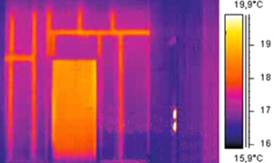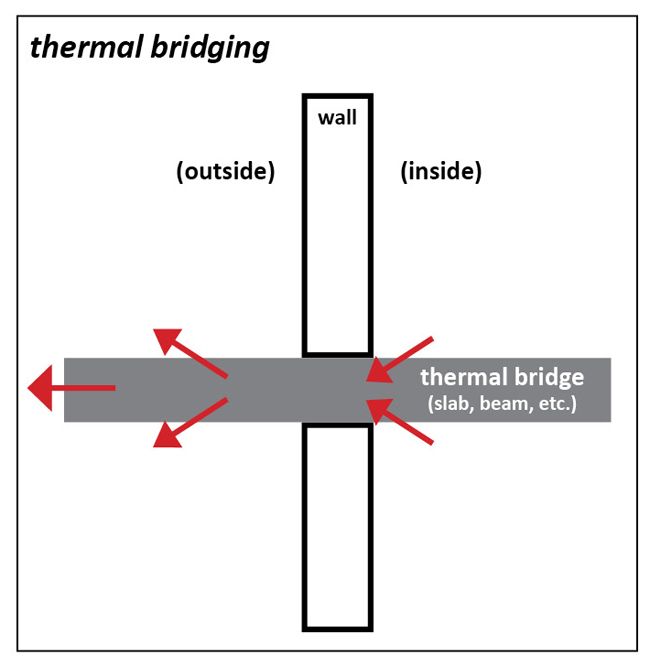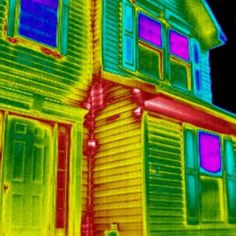Definition and Types of Thermal Bridges


How to Improve Energy Efficiency
In the never ending struggle for improved energy efficiency, people have been trying to find alternative ways of improving and upgrading their household thermal performance. This includes not only proper insulation but also other means of protection that can successfully deal with some side effects of poorly insulated buildings. One such side affect but also a great problem for today’s households is connected to the appearance of thermal bridging. Namely, as the energy efficiency requirements grew over the years, so did the necessity for proper insulation, which however only opened other problems that had to be dealt with in order of achieving a satisfying result. Studies have shown that thermal bridges can present almost 30% of the overall conduction heat loss, which only shows the magnitude of the problem. Another valuable fact is that, apart from the significant heat loss, thermal bridges can also cause other problems including heat gain during summer months, cold spots, damage to the construction, and increased risk of condensation which can lead to mould growth and reduced indoor air quality. This is why we will discuss the definition and types of thermal bridges, in order of trying to minimize the risk of their appearance, since unfortunately they can never be completely eliminated.
What is Thermal Bridging?
In order of defining thermal bridges, what you need to understand first is the fact that each insulation material and material used in construction has its level of thermal transmittance i.e. thermal conductivity shown through its U value. Higher U value results in higher conductivity rate. Well, when such material that has high thermal transmittance appears in a building envelope (when there are discontinuities in the thermal envelope, for example) and is surrounded with materials that have lower thermal conductivities, a path is created that allows the heat to flow from a warm to a cold space which results in lower temperature of the thermal bridge interior surface and thus reduced thermal insulation of the entire construction.

Areas where different types of thermal bridges are most likely to occur are floor and wall junctions, corners, around windows and doors, and are usually caused by inadequate insulation (that is gaps in insulation) or some construction issues.
Classification of thermal bridges includes three basic types:
- Repeating thermal bridges which are usually evenly distributed over the building envelope and follow a regular path. These are most likely to occur in insulated cold pitched roofs at ceiling joists, insulated suspended timber floor at ground floor joists, timber frame constructions, steel wall ties in masonry walls or mortar joints in inner wall leaves.
- Non-repeating (linear) thermal bridges are most commonly caused by discontinuities in the building envelope and can appear around openings such as windows and door openings, around loft hatches, rooflights, internal walls and floors junctions.
- Geometrical ones depend on the shape of the structure and can appear as two-dimensional or three-dimensional, usually occurring at external wall corners, and at junctions including window and wall or door and wall junctions, wall and roof junctions, wall and floor junctions, or adjacent wall junctions.
The calculation of thermal bridges will depend on their type and some other corrections such as potential air gaps or mechanical penetrations in the insulation layer. When calculating repeating ones, combined areas method is usually applied, whereas upper and lower limits of thermal resistance are taken into account and the arithmetic mean is used to determine the U value of the entire construction. For the other two types, the amount of heat floe caused by the thermal bridge is calculated and added separately.
How to Identify Thermal Bridges
In order of dealing with potential problems, you need to identify them first. The same goes for thermal bridges, since although these typically occur at specific spaces and areas within your home, you will not be aware of the magnitude of the problem, until you have taken some actions in order of defining it. Thermal bridges can be identified with infrared thermal imaging, which allows you to take proper measurements from both inside and out of your household. When looking from outside in, you will see the bridges as areas of high temperature (shown red) while when looking from inside out, they would appear as areas of lower temperatures (shown blue).

However, in order of doing the job right and gaining proper and applicable results, the measurements need to take place under adequate conditions. The building that is under inspection needs to be thermally stable and the difference between the inner and outer temperature apparent. On the other hand, when determining thermal bridges from the outside, it is best done early in the morning or when the sky is overcast. Please note that various factors can influence the obtained result, including service voids, air leaks, uninsulated pipework or direct sunlight, which need to be taken into account.
Stop thermal bridging in your home today, contact us and get a free quote with the lowest prices for your insulation project.




































































































































